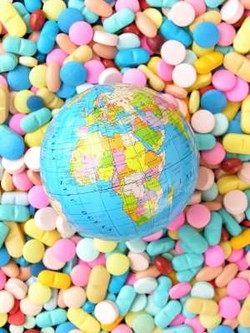Medicines regulation reforms in Africa 'incomplete', says WHO
Phil Taylor, 05-Sep-2013
 An ongoing effort to harmonise medicines regulation in Africa could increase access to drugs but lacks critical post-marketing surveillance provisions, according to the World Health Organisation.
An ongoing effort to harmonise medicines regulation in Africa could increase access to drugs but lacks critical post-marketing surveillance provisions, according to the World Health Organisation.
The African Medicines Registration Harmonization (AMRH) initiative first set up in 2009 is trying to develop a unified platform for registering new drugs which should speed up the availability of new medicines.
The WHO says the effort is laudable and will bring many benefits, but the pack of a proper post-market monitoring framework omits a critical tool for protecting the public from spurious/falsely labelled/falsified and counterfeit medical products (SSFFCs).
Meanwhile, as the AMRH could lead to a dramatic increase in drug usage in Africa, which will in turn boost the incidence of drug-related side effects and death that can only be picked up with proper pharmacovigilance (PV) procedures.
"Nearly 50 per cent of the PV systems [in Africa] have been established only recently and do not have the experience to address the broad range of challenges that are bound to accompany improved access to medicines," says the WHO in its report on the 10th meeting of its Advisory Committee on Safety of Medicinal Products (ACSoMP), which took place in April.
ACSoMP issued a call at the meeting for donors, governments and technical agencies and other stakeholders to ensure that the AMRH is accompanied by schemes for post-market surveillance of registered medicines.
Rapid alert system rolling out
Meanwhile, the Committee also noted at the meeting that the WHO's Rapid Alert tool for reporting SSFFCs to a centralised database has completed a 10-nation pilot phase and is now rolling out in additional countries.
One of the last countries to adopt the system is Nigeria, which signed up to use it in July. The system uses a standardised electronic form with a hidden language recognition code that enables the form to be completed in one language and automatically translated to English when downloaded into the database retained at WHO's Geneva headquarters.
The database automatically strips out duplicate reports - for example spotting if a batch number has been uploaded before - and notifies WHO staff who can then assess the level of risk and act accordingly.
Given that illicit medicines are hard to spot - particularly if they have some therapeutic effect from a small amount of active ingredient for example - PV can be another set of "eyes and ears" to help identify SSFFCs, notes the ACSoMP.
WHO is also developing data mining methods to try to identify unusual clusters of reports of a lack of efficacy or adverse reactions in patients which may be caused by SSFFC medical products, with PV data likely to be a key source.

©
SecuringIndustry.com




 An ongoing effort to harmonise medicines regulation in Africa could increase access to drugs but lacks critical post-marketing surveillance provisions, according to the World Health Organisation.
An ongoing effort to harmonise medicines regulation in Africa could increase access to drugs but lacks critical post-marketing surveillance provisions, according to the World Health Organisation.